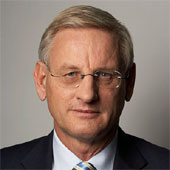Europe and the Third Wave of Globalization
How will large demographic shifts in developing countries impact Europe?
October 8, 2003
Would you believe that in 2003, capital exports to the world's developing countries in relative terms are still smaller than they were back in 1945?
Well, the good news is this: Over time, this will change.
Developing countries will need capital from industrialized countries to finance their investment needs — and we will need the return on that capital for our pensions.
This will be the global new deal. Financial issues aside, we have to realize that migration is far more limited now than it was in earlier stages of globalization.
In that first wave up to 1914, approximately 10% of the population of the world moved from one country to another — and in many cases from one continent to another.
The millions that went from Europe to America are only a small part of this great story. In our present third wave of globalization, so far only 2% of the global population has moved across borders.
It is one of the safest of predictions that this figure will increase in the decades ahead. And it is equally safe to assume that this will have a profound effect on the future of Europe.
There is no holding back the tide. Just consider that the United States alone makes more than 1.5 million arrests along the Rio Grande border to Mexico every year.
Still, the country's Hispanic population just continues to grow. There are more Hispanics in the United States than the entire population of Canada.
A metropolis like Los Angeles is turning Hispanic in more than just its name. For Europe, the situation is even more demanding. Look at our “near abroad.”
To the EU's East, we have Russia — a country in dramatic demographic decline.
But to our South and Southeast, we have a Muslim and Arab world — and it is in the midst of a demographic explosion.
Today, the 22 Arab countries have a population of approximately 280 million people. But within two decades, this is likely to grow to approximately 450 million.
It's a region with a greater proportion of young people than any other in the world. Today, 38% of its population is below 14 years of age.
And while the population of Arab countries is exploding, their economies are stagnating. During the last two decades, the Arab world has had the weakest economic development of any region in the world — with the exception of sub-Saharan Africa.
Worse, even the abundance of fossil fuel resources has not prevented its economic standard from radically declining in compared to the rest of the world.
The combined exports of Arab countries — excluding energy — are no larger than the exports of Finland. Their combined economies including energy are no larger than that of Spain.
The barriers to growth are big. Seven of the ten largest Arab League member countries are still outside the World Trade Organization.
A third of the women in these countries can't read or write. And the region has the lowest Internet penetration of any region of the world — including sub-Saharan Africa.
If we leave the profound political issues of what we once used to call the Fertile Crescent apart we still have reason for deep concern.
That crescent encompasses the state of the lands of Mesopotamia (after three decades of dictatorship, two decades of de facto war and one decade of devastating sanctions).
It also includes the state of the lands of the Jordan River — even as the relationship between Jews and Palestinians continue to deteriorate.
With all this in mind, it's not difficult to see the near certainty of economic and social implosions that will lead to political explosions that could cause millions to seek their future somewhere else.
A recent UN survey indicated that half of the population wanted to leave the Arab countries and the region. However much they might dream of Manhattan, they are more likely to end up in the suburbs of Milano, Marseilles, Manchester or Munich.
By the same token, whatever their numbers will be in the years to come, success or failure in integrating them could decide the inner stability and security of our societies some decades into the future.
There are already 50 mosques in Berlin, and more than 150 mosques in London. It is no longer a question of whether we will live with Islam in our societies — but how we will do it.
Either there will develop an Islam of the ghettoes that will risk breeding fundamentalism and conflict. Or there will develop an Islam of Europe that combines its own beliefs with the values of ways of our modern secular societies
I need not elaborate on the importance of this. As we ask ourselves whether Europe is ready for the future, the pressure is truly on. Why? Evidently, all of these issues come together.
That is why we must move forward with the federation of nation states, encompassing all of Europe to the West of Russia and the Ukraine.
We have failed to address properly the required economic revolution. And we have yet to grasp fully the magnitude and the consequences of the demographic revolution we will see in our own European societies.
Nor have we considered the significance of the large demographic shifts both in our relationship to the United States — and in the impact that it will have in the "near abroad" of ours that is the Greater Middle East.
Thus, we have no reason to be complacent. The tasks ahead are even greater than the tasks that are behind us. Clearly, we are not yet ready for the future.
The challenges ahead require an open debate, a profound search for new ways and a political leadership that is truly European and profoundly visionary.
Read previous
Is Manufacturing Disappearing?
October 7, 2003
